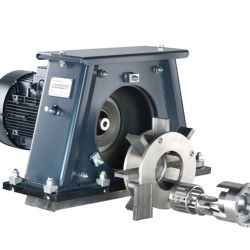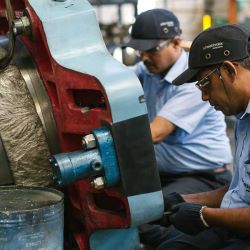‘Smart’ machines make Aerospace peening a precision art
There’s a clear reason why Aerospace engineering is driving innovation and development in shot peening – put simply, if something goes wrong in Aerospace, people’s lives are on the line. A broken-down car is annoying, but a broken-down plane could fall from the sky. This means that quality and precision for Aerospace shot peening is paramount.
Shot peening is used in Aerospace to strengthen parts against fatigue. As engineers are striving to make aircrafts lighter and faster, a reduction in the weight of parts is an obvious result. This means shot peening has become an ever more important process to strengthen and protect these lighter parts.
Over the last 10 years, more people have become involved in the shot peening process for Aerospace. The big OEMs don’t always carry out peening themselves, instead using contracted companies who supply these services.
This reliance on high quality, repeatable shot peening results in Aerospace has pushed equipment manufacturers like us to deliver machines that are ‘smarter’ than ever before.
Smart machines with enhanced process controls
The area of shot peening that is evolving most rapidly is the computer controls of the machines. The ability to precisely control the shot peening process, even in real-time during the blast cycle, is now very much a reality.
In Aerospace, peening is predominantly done via airblasting and the two elements where precision control is particularly important are air pressure and shot flow. The impact of shot peening on a part equates to the kinetic energy of the substrate, calculated using the classic kinetic energy equation, ke = ½mv2.
The air pressure is directly related to the velocity of the shot (v in the equation), while the shot flow is directly related to the mass (m). Therefore, being able to control these two elements precisely significantly enhances the quality, accuracy and repeatability of shot peening results.
Machinery that keeps pace with software development
Alongside the improvements we’ve been working on in computer controls and software applications, Wheelabrator has also been looking at ways to ensure the machinery itself keeps pace.
The increased use of 3D modelling over the last decade has improved the repeatability of the mechanical elements of a machine, ensuring that a machine can be simply replicated. This means the exact same results can be delivered across multiple machines.
In addition, the development and testing of various parts within the machines is allowing us to ensure machine parts can deliver the precision demanded by enhanced software. For example, as well as improving the computer systems controlling shot flow, we have developed new shot flow control valves which aim to match the sophistication on the process controls.
The future is data driven
We don’t predict that the future will hold giant leaps forward in shot peening technology. Instead it will continue to be an evolutionary process, with peening equipment becoming more and more like machine tools.
Data gathering during peening, which is allowing us to have an ever tighter grip on the process, is also giving us more and more insight with which to develop even better machines.
Already we are starting to see more automation and robotics in control of the shot peening process in Aerospace, and I believe this trend is only going to grow as we gather more data. As the amount of data increases, our machines will continue to get smarter, ensuring precision and repeatability in shot peening across not just Aerospace, but all industries.


